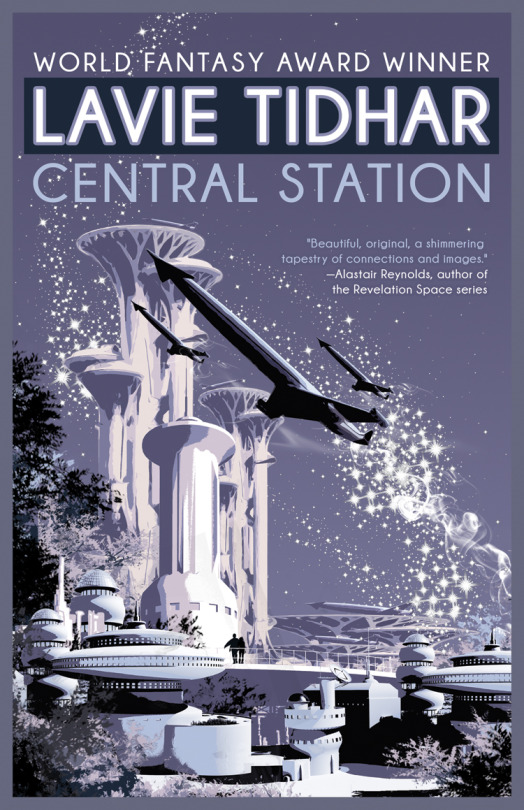CENTRAL STATION is a genuine pleasure to read because it feels “real”
Lavie Tidhar’s excellent CENTRAL STATION continues to garner a lot of attention.

For THE ANGLIA RUSKIN
CENTRE FOR SCIENCE FICTION AND FANTASY, Maureen Kincaid Speller praises the quotidian tale.
I start with Achimwene because he reminds us that one of the central themes of Lavie Tidhar’s CENTRAL STATION is the telling of stories, and science-fiction stories in particular. Indeed, the narrative itself is an embodiment of a pivotal moment in sf storytelling: the move from short story to novel. The earliest sf novels weren’t novels as such; they were formed from several closely connected short stories, sometimes reworked to strengthen those connections, and were known as ‘fix-ups’. CENTRAL STATION is a fix-up par excellence, bringing together Tidhar’s various Central Station stories, some of them substantially reworked, with a couple of new stories added to the mix, and a Prologue that introduces the novel as an act of storytelling, while itself participating in the act of storytelling not once but twice.
Fix-ups, embedded narratives – there are already many layers of story at work and the novel has barely begun. It will, though, take a couple of chapters for the reader to notice that CENTRAL STATION isn’t so much one story chronologically narrated as a series of stories, a mosaic, if you like, and if the reader knows Ray Bradbury’s MARTIAN CHRONICLES at all, the general ambience of the narrative may seem begin to seem somewhat familiar. Those who have read C.L. Moore’s ‘Shambleau’ will recognise the term when it is used in Chapter Five: Strigoi. Likewise, the reference to St C’mell might call forth a memory of Cordwainer Smith’s ‘The Ballad of Lost C’mell’. And if not, that doesn’t matter either, because, while CENTRAL STATION rests on a foundation composed of all these stories, and many others I’ve either forgotten or never read, it doesn’t rely them to tell its story.
<snip>
And that, I think, is probably the most significant message CENTRAL STATION has to offer us: even in science fiction, that so-called literature of the future, nothing lasts forever. The symbolic tropes – space ships, robots, AIs – will all eventually be absorbed and become part of the scenery. I’m not talking about decay or decline. There is rarely a moment when one thing is actively replaced by another, in a single moment. As we know even now, different technologies can co-exist alongside one another for years in the right circumstances. Central Station suggests to me that the familiar tropes of traditional sf will continue to exist quite happily alongside the genre-busting stories I love so much but that their continued existence relies on the willingness of authors like Tidhar to look at them from a different angle.
There comes a time in a man’s life when he realises stories are lies. Things do not end neatly. The enforced narratives a human impinges on the chaotic mess that is life become empty labels … (163)
That’s what I see going on here. CENTRAL STATION is not clinically futuristic; instead it is quotidian. And in being quotidian it offers the space for so many things that readers and critics of science fiction have argued for – ordinary women going about their daily business; a diverse cast of characters drawn together by likely circumstance rather than authorial anxiety; space travel being no more important than bus travel; people just about making ends meet, like most of us do; a future in which the ordinary and the extraordinary continue to meet and collapse into one other, much as they’ve always done, and a literature in which, while the past provides a foundation for the future, it does not insist on continuing to shape that future. Tidhar offers us a messy human future, in which people, using the term in its widest sense, live, love, bicker, experience fear, joy and wonder, a future which never quite comes to a neat and tidy end. As such, although I tend to avoid traditional future narratives, CENTRAL STATION is a genuine pleasure to read because it feels ‘real’ to me in a way that so many future narratives don’t. I said before that too many futures I read about don’t seem to have room for me in them: this is a future that does.

Photo: Kevin Nixon. © Future Publishing 2013
Holly Best at THANK THE MAKER enjoys the book.
Lavie Tidhar has created a far-reaching fantastical future that feels concurrently alarmingly exotic yet satisfyingly familiar. Within a short timespan we peak into the lives of an interwoven group of people, all, searching. The story of life, the need for acceptance, the desires and sorrows of the heart remain true, whatever the century. This is the story of the every man, woman, robot, sentient creature, data-vampire, that falls in love, finds religion, eventually losing both all the while managing to survive. It is the story of family – the need to remember and the cost of holding too dear to that very past.
CENTRAL STATION breathes new life into the genre – more so thanks to it’s non-American slant, bringing this SF story to Tel Aviv, highlighting Judaic culture, mingling the elements of the migrant. CENTRAL STATION is not an everyday space story, just as this does not appear to be your average snow storm.
The Russian LIVELIB gives the novel, 5/5.
The main feature of the novel is that it does not give answers. He does not end at all in mid-sentence and does not leave the reader in reflection, how really everything was. Tidhar acts more subtle and more refined. He shows a piece of the world that is on the verge of change. We will never know what will happen next and why some events are happening – will children from genetic laboratories become the first step towards posthumanity and the rejection of the mortal body in favor of virtual reason? Why does the mysterious wanderer Eliezer create gods, and what do the last of them represent? Was Carmel cured of her vampire affliction? What is actually the mysterious nakaimas and what do the Others talk about in their mysterious and untranslatable language? All these questions hang in space, stretch invisible threads into the future, which will not come, because the novel does not presuppose continuation. This is an ideal example of how to leave details to the reader. Someone will be annoyed by this approach, someone will give an inexhaustible scope for imagination and guesswork, but the main message that life goes on, and it does not matter in what form is beautiful and amazing. CENTRAL STATION leaves a wonderful aftertaste, pleases with vivid, voluminous and very different images; Charming, if not lyrical, pictures of the world. Levi Tidhar created an amazing story, both human and not so, oriented to the future and full of memories of the past, combining nf reality and fantasy fantasy, all in organic proportions.
Translation for Russian, courtesy of Google.
MAIJA
READS trys the first chapter of the intriguing CENTRAL STATION.
For more info about CENTRAL STATION, visit the Tachyon page.
Cover and image by Sarah Anne Langton
